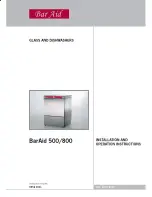
21
Possible causes
- Improper loading
- Overloaded baskets
Possible causes
- The dishes were pre-washed by
hand with a large amount of dish
detergent
- Rinse aid has accidentally leaked
into the machine
- The cover of the rinse aid
dispenser was not closed.
Possible causes
- Clogged filters
- Drain hose bent. Relief hose
blocked or bent.
6
Softening the water
Dishwashers require fairly soft water. If the hardness exceeds 6°dH lime scale will form on crockery. To avoid
this an automatic system adds a special salt to soften the water so that you obtain the best possible cleaning
and drying performance.
To find out the hardness level of your water contact your local water company, or use the enclosed test strip to
measure the water hardness:
Setting the water hardness level for the water softener
Turn on the tap and
let the water run for
about a minute.
Hold the test strip in
the water for about a
second.
Remove the test strip
from the water and
shake it.
Wait for 1 minute.The test strip shows
you the hardness
level.
1 min.
b
e
1 Minute
1 Second
c
d
f
a
1.Press the
Program Selection Button
before you switch the appliance on and keep this button
pressed down.
2.Switch the appliance on using the
On/Off
Switch, then release the switch.
3.Hold the Program Selection Button down for 10 seconds until the Control Indicator on the
Start/Pause Button begins to flash.
4.Water hardness can be set to the desired level by pressing the
Program Selection Button
(Compare the test strip with the Degrees of Hardness Table). The Multi-Function Display shows
the appropriate message.
5.Once you have set the hardness level press the
Start/Pause
Button to save the value. The
Control Indicator on the Start/Pause Button now lights up permanently.
Switch the appliance off again using the On/Off
switch.
If the water hardness level is less than 5°dH you do not need any special softening
salt. In this case the 'Salt' Control Indicator lights up continually (depending on the
model).
If your local hardness level exceeds 45°dH you should consider getting a water
softening device for your dishwasher.
If you use stream water or rainwater you are recommended to install filters.
If you move do not forget to adjust the water hardness level to suit your new
neighbourhood.
Remove the test strip
from the packet.
Hardness Level
Hardness Level
British
hardn.
°dE
German
hardn.
°dH
French
hardn.
°dF
Regeneration
Adjustment
Switch
0
1
0
1
0
1
0
1
0
1
0
1
0
1
0
1
0
1
0
1
0
1
0
1
If water hardness Level is 6 (high
lime content), turn the Regeneration
Adjustment switch on position 1.
Regeneration Adjustment
Switch
0
1
High lime content
Level 6
1
2
3
4
5
6
Indicator in the Multi-Function Display
The display shows the
message:
The display shows the
message:
The display shows the
message:
The display shows the
message:
The display shows the
message:
The display shows the
message:
0-5
6-11
12-17
18-22
0-9
10-20
21-30
31-40
0-6
7-14
15-21
22-28
23-34
41-60
29-42
35-60
61-107
43-75
4
°dH: German hardness level
1 °dH = 1 mg CaO/100 ml Water = 0.179 mmol
Foam
Water remains inside the
machine after the rinse cycle
Dishes break
How to fix these problems
- Load the dishwasher as suggested in the directions.
- Do not overload the dish baskets. Dishes may hit against
each other and break.
How to fix these problems
- Dishes do not need to be pre-washed. Coarse dirt may be
removed with a dishcloth, or you may hold the dishes under
running water.
- If rinse aid has been spilled during refilling, remove the agent
using a paper cloth or sponge.
- Always take care to ensure that the lid is closed after refilling
the rinse aid dispenser.
How to fix these problems
- Clean all strainers and filters as described in the manual
- Ensure that the relief hose is properly placed.
































